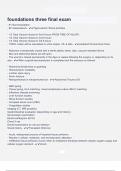STUVIA 2024/2025
foundations three final exam
- #1 fluid resusitation
- #2 vasopressors - ✔✔Hypovolemic Shock priorities
- 1/2 Total Volume infused in first 8 hours FROM TIME OF INJURY
- 1/4 Total Volume infused in 2nd 8 hours
- 1/4 Total Volume infused in 3rd 8 hours
- THEN: orders will be calculated on urine output, VS, & labs - ✔✔parkland formula time frame
- Abdomen is temporarily closed with a sterile plastic sheet, clips, vacuum-assisted device
- Skin and abdominal fascia are left open,
- The wound is closed permanently in the days or weeks following the surgery or, depending on its
size - ✔✔After surgical decompression is completed and the pressure is relieved
- Abdominal tenderness or guarding
- Hemodynamic instability
- Lumbar spine injury
- Pelvic fracture
- Retroperitoneal or intraperitoneal air - ✔✔Abdominal Trauma S/S
%
- ABO typing
- Tissue typing, HLA matching, mixed lymphocyte culture (MLC) matching
- Infectious disease screening
- Liver function studies
- Renal function studies
- Complete blood count (CBC)
- Coagulation studies
Imaging (CT, MRI possibly)
Gastrointestinal evaluation (depending on age and history)
Gynecologic examination
Electrocardiogram (ECG)
Chest X-ray
Dental examination to rule out infection
Social history - ✔✔Transplant Work-Up
- Acute, widespread process of impaired tissue perfusion
- Results in cellular, metabolic, and hemodynamic alteration
- Ineffective tissue perfusion occurs when an imbalance develops between cellular oxygen supply and
cellular oxygen demand - ✔✔shock
stuvia
, STUVIA 2024/2025
- Administer supplemental oxygen - Mechanical ventilation
For life-threatening conditions (eg, tension pneumothorax)
--- Insert chest tubes - ✔✔Trauma breathing: immediate care
- Admitted typically as a trauma due to other injuries usually present from the force of the electrical
current
• Think C-spine precautions...ALWAYS until cleared - ✔✔Electrical Injury
- Air continuing to enter the pleural space without being able to leave the pleural space
- Compression of the trachea, heart, lungs, or great vessels
- resp. failure, compromised venous return, insufficient cardiac output - ✔✔Thoracic Trauma:
Tension Pneumothorax
- Airway management
- Pain management
- Oxygen therapy to maintain adequate saturation - ✔✔Initial management of flail chest and other
bony thorax fractures
- All MS injuries require continuous assessment
%
- Infection is common in open injuries - ✔✔Musculoskeletal Trauma
- ALL of the patient's clothing is removed
- Allow for a thorough examination of all body surfaces for the presence of injury
- Patient is turned (logrolled) while full spinal precautions are maintained - ✔✔Exposure how they do
it
- Antihistamine (Benadryl)
Epinephrine (SQ or IM) Reverse vasodilation and bronchoconstriction
- Corticosteroids,
- bronchodilators
- Vasoconstrictors (only with severe cases) - ✔✔Anaphylactic Shock: Medications (REVERSE
biochemical response)
- Any severe illness of injury that causes SIRS can lead to MODS
- Pathophysiology similar to sepsis Release of systemic inflammatory mediators - ✔✔Multiple Organ
Dysfunction Syndrome (MODS)
- approximately 30% to 40% of circulating blood volume is lost - ✔✔Hypovolemic shock may not
appear until
stuvia
, STUVIA 2024/2025
- areas of burns 2nd and 3rd degree - ✔✔• Lund and Browder chart indicate
- Avoid known allergens; the best way to prevent anaphylactic shock
-Anaphylactic shock may occur without any known predisposing factors - ✔✔Anaphylactic Shock:
History of allergies
- Baroreceptors (decreased stimulation)
- SNS activation
- Increased heart rate and contractility
- Vasoconstriction of blood vessels - ✔✔neural reponse to shock
- Beta-adrenergic agonist
- Used in the postoperative period for chronotropic (heart rate) support - ✔✔Heart Transplantation:
Post Op : treat bradycardia with other : Isoproterenol (Isuprel)
- Binding agents to remove toxic levels of metals from the body
- Ex: Lead, arsenic, iron - ✔✔Enhanced Elimination of the Drug/Toxin : Chelation
- Binds drugs and keep them in the stomach and intestines
%
- Reduces the amount absorbed into the blood
- The drug, bound to the charcoal, is then expelled in the stool - ✔✔Absorbents for poisining: Ex:
Activated charcoal
- Blood fills the pericardial space and compressing the heart
- Reduced cardiac output, reduced contractility, and eventually shock - ✔✔Cardiac Tamponade what
happens
- Blunt or penetrating trauma
- Ruptured bronchi often are present in association with upper rib fractures and pneumothorax -
✔✔Tracheobronchial trauma
- Bronchoconstriction
- Coronary vasoconstriction
- Death due to circulatory collapse or extreme bronchoconstriction can occur within minutes or hours -
✔✔Anaphylactic Shock other S/S
- Burn depth and size
CBC,
chemistry, BUN/creatinine,
stuvia
, STUVIA 2024/2025
UA,
ABGs,
ECG,
chest x-ray - ✔✔Burn Management tests
- Can donate HSCT, kidney, liver, pancreas, lung
- Thorough medical evaluation of potential donor, education, and counseling - ✔✔living donors
- Cardiac pumping function fails
- Myocardial infarction (MI)
- Abnormal heart rate or rhythm
- Impaired diastolic filling
- DECREASED Cardiac output, INCREASED preload - ✔✔Cardiogenic SHOCK
- Caused by exposure to acids or alkali
- Contact time is directly related to the severity of injury
- Must rinse and irrigate the area immediately with water - ✔✔• Chemical burns
- Cellular response to the initial trauma that can make the primary injury worse
- Caused by ischemia, hypotension, hypercapnia, cerebral edema - ✔✔TBI: Secondary brain injury
%
- chest pain
- SBP<90 mm Hg
- CI (<2.2 L/min)
- Weak, thready pulse
- Diminished heart sounds
- Cool skin
- Oliguria (<30 mL/hr)
- Decreased mentation
- Dyspnea, tachypnea
- Crackles
- Increase CVP, PA pressure
- Elevated myocardial tissue markers (troponin), BNP - ✔✔Cardiogenic Shock: S/S Assessment
findings are similar to HF but are more severe
- Child different in proportionate and size
- Use patient's palmar surface to determine size
- Rule of 9's - ✔✔• TBSA (Total body surface area)
- Close observation of pulse oximetry and ABGs
stuvia




